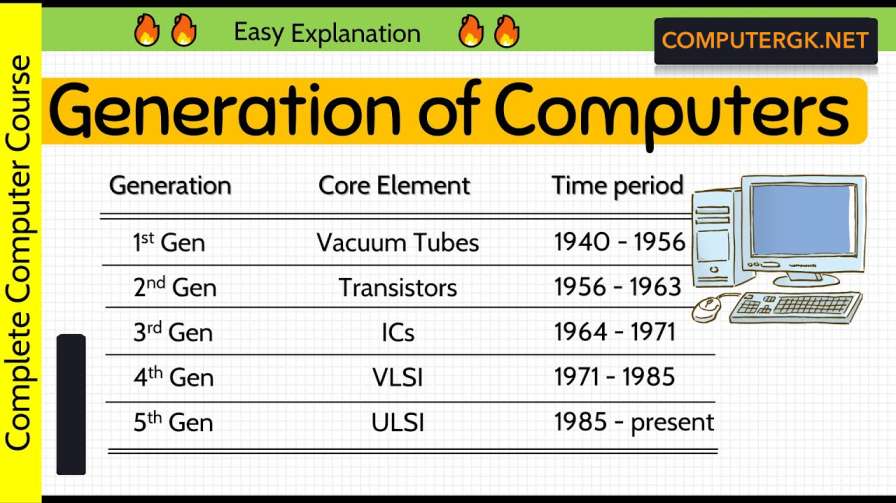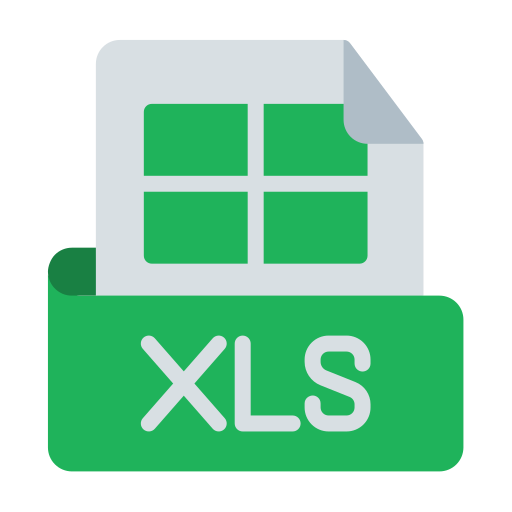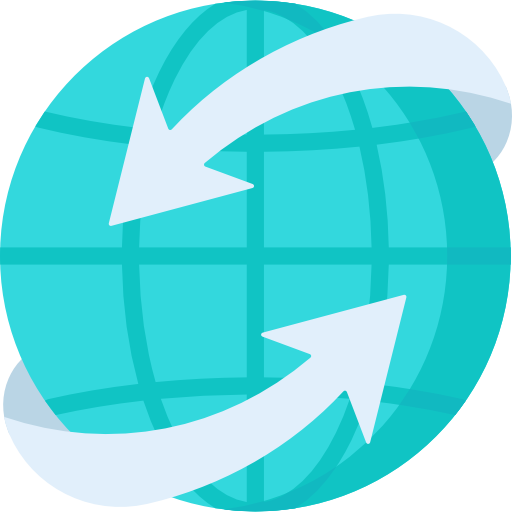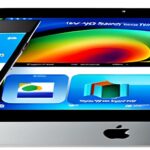Generation of Computer | Details Notes With Free PDF
Table of Contents
The generation of A computer refers to the historical development of computing hardware and its evolution over time. The most commonly recognized generations of computers are:
- First Generation (1940-1956): Vacuum Tube Computers
- Second Generation (1956-1963): Transistor Computers
- Third Generation (1964-1971): Integrated Circuit Computers
- Fourth Generation (1971-Present): Microprocessor Computers
- Fifth Generation (Present and Beyond): Artificial Intelligence Computers

Notes on Generation of Computer
Each generation is characterized by improvements in technology and computing power, leading to smaller, faster, and more efficient devices.
First Generation of Computer
- The first generation of computers, which ran from 1940 to 1956, was characterized by the use of vacuum tubes as the primary electronic component.
- These computers were large, bulky, and consumed a lot of power. They were also slow and prone to frequent failures due to the vacuum tubes overheating.
- Some of the first generation computers include the ENIAC, UNIVAC I, and IBM 701.
- These computers were mainly used for scientific and military applications, as they were too expensive and complex for general use.
- The first generation computers were limited in their capabilities, but they marked the beginning of the computer revolution and laid the foundation for the development of future generations of computers.
Advantages of First Generation Computers (1946-1959):
- Large-scale calculation: The first computers were capable of performing large-scale calculations, which made them ideal for scientific, military and business applications.
- Speed: Compared to manual methods of calculation, the first computers were very fast.
- Reliability: The vacuum tubes and magnetic drums used in first-generation computers were very reliable compared to manual methods.
Disadvantages of First Generation Computers:
- Size: First-generation computers were very large, often taking up entire rooms, which made them difficult to use in many settings.
- Cost: These computers were extremely expensive to build and maintain, making them accessible only to large organizations and governments.
- Heat: Vacuum tubes generated a lot of heat, which made the computers prone to overheating and failure.
- Maintenance: The vacuum tubes used in first-generation computers required frequent replacement, which was time-consuming and costly.
- Power consumption: The vacuum tubes used a lot of electricity, which made the computers power-hungry and expensive to run.
- Limited memory: First-generation computers had very limited memory, which made it difficult to store and access large amounts of data.
second generation of computer
- The second generation of computers, which ran from 1956 to 1963, marked a major turning point in the history of computing.
- The main technological advancement during this era was the replacement of vacuum tubes with transistors, leading to smaller, faster, and more reliable computers.
- These computers used magnetic core memory and assembly language programming, which made it possible to create more complex programs.
- The second generation computers were still large and expensive, but they were more accessible to businesses and universities.
- Some of the well-known second-generation computers include the IBM 1401, UNIVAC 1108, and DEC PDP-1.
- The second generation computers paved the way for the development of the third generation of computers, which introduced the use of integrated circuits.
Advantages of Second Generation Computers (1959-1965):
- Smaller size: Second-generation computers were smaller in size compared to first-generation computers, making them easier to use in a wider range of settings.
- Lower cost: The use of transistors instead of vacuum tubes made second-generation computers less expensive to produce and maintain.
- Increased reliability: Transistors were more reliable than vacuum tubes, which resulted in fewer breakdowns and less maintenance.
- Increased memory: Second-generation computers had larger and more sophisticated memory systems, which allowed for the storage and retrieval of more data.
Disadvantages of Second Generation Computers:
- Limited processing power: Second-generation computers were still relatively slow compared to modern computers.
- Limited storage capacity: Although memory capacity increased, storage capacity was still limited.
- Lack of standardization: There was a lack of standardization among second-generation computers, which made it difficult to develop software that could run on multiple systems.
- High power consumption: Second-generation computers still consumed a lot of electricity, which made them expensive to run.
- Limited operating systems: Operating systems were limited, which made it difficult to perform multiple tasks simultaneously.
- Lack of user-friendly interface: Second-generation computers lacked the graphical user interface (GUI) that is common in modern computers, making them less user-friendly.
3rd generation of computer
- The third generation of computers, which ran from 1964 to 1971, marked another major leap forward in the history of computing.
- The introduction of the integrated circuit, or microchip, was the key technological development during this era. Microchips made it possible to integrate many transistors onto a single silicon wafer, leading to smaller, faster, and less expensive computers.
- This generation of computers was characterized by the use of operating systems, which made it easier for users to interact with the computer and perform multiple tasks simultaneously.
- Third-generation computers also saw the widespread use of graphical user interfaces (GUIs), which made it easier for users to interact with the computer using a mouse and keyboard. Some of the well-known third-generation computers include the IBM 360, PDP-8, and DEC VAX.
- The third generation of computers marked the beginning of the personal computing era, which has continued to evolve to this day.
Advantages of Third Generation Computers (1965-1971):
- Increased processing power: Third-generation computers had faster processing speeds compared to previous generations, which allowed for more complex calculations and simulations.
- Increased storage capacity: Third-generation computers had larger memory and storage capacities, which allowed for the storage and retrieval of even more data.
- Improved reliability: Third-generation computers were more reliable than previous generations, with fewer breakdowns and less maintenance required.
- User-friendly interface: The development of the graphical user interface (GUI) made third-generation computers more user-friendly and accessible.
- Standardization: Third-generation computers saw the development of standard operating systems, which allowed for the development of software that could run on multiple systems.
Disadvantages of Third Generation Computers:
- Cost: Third-generation computers were still relatively expensive, making them inaccessible to many individuals and smaller organizations.
- Power consumption: Third-generation computers still consumed a significant amount of electricity, which made them expensive to run.
- Limited portability: Third-generation computers were still relatively large and heavy, making them difficult to transport.
- Limited programming languages: Third-generation computers relied on specialized programming languages, which limited the pool of available developers.
- Lack of backward compatibility: Third-generation computers were not backwards compatible with previous generations, which made it difficult to use older software and hardware.
4th generation of computer
- The fourth generation of computers, which began in 1971 and continues to the present day, is characterized by the widespread use of microprocessors.
- A microprocessor is a single chip that contains the central processing unit (CPU) of a computer, making it possible to build smaller, less expensive, and more powerful computers.
- The fourth generation of computers saw the development of personal computers, such as the IBM PC and Apple Macintosh, which made computing accessible to individuals and households.
- The use of the Internet and the World Wide Web, which emerged during this time, also transformed the way people used computers and communicated with each other.
- This generation of computers also saw the introduction of new technologies such as laptops, smartphones, and tablet computers, which have greatly expanded the reach and capabilities of computing.
- The fourth generation of computers continues to evolve, with ongoing developments in artificial intelligence, cloud computing, and the Internet of Things.
Advantages of Fourth Generation Computers (1971-Present):
- Smaller size: Fourth-generation computers were much smaller in size compared to previous generations, making them easier to use and transport.
- Lower cost: Fourth-generation computers became more affordable, making them accessible to a wider range of individuals and organizations.
- Increased processing power: Fourth-generation computers had even faster processing speeds, which allowed for even more complex calculations and simulations.
- Increased storage capacity: Fourth-generation computers had even larger memory and storage capacities, which allowed for the storage of vast amounts of data.
- Improved reliability: Fourth-generation computers continued to be more reliable than previous generations, with fewer breakdowns and less maintenance required.
- Widespread use of microprocessors: The widespread use of microprocessors in fourth-generation computers made them more versatile and useful for a wider range of applications.
Disadvantages of Fourth Generation Computers:
- Power consumption: Although fourth-generation computers were more energy-efficient than previous generations, they still consumed a significant amount of electricity.
- Dependence on electricity: Fourth-generation computers were dependent on a constant supply of electricity, which made them vulnerable to power outages and other disruptions.
- Security concerns: Fourth-generation computers were vulnerable to viruses, malware, and other security threats, which required constant vigilance and protection.
- High-tech skills required: Fourth-generation computers required a certain level of technical proficiency to use effectively, which limited their accessibility to some individuals.
- Environmental impact: The production and disposal of fourth-generation computers had a significant impact on the environment, which raised concerns about sustainability.
5th Generation of computer
- The 5th generation of computers, which started around 1980, is characterized by the development of artificial intelligence (AI) technology.
- This generation of computers saw the introduction of parallel processing, expert systems, and natural language processing, which allowed for more human-like interaction with computers.
- The development of the graphical user interface (GUI) also made computers more accessible and user-friendly.
- Some of the notable examples of 5th-generation computers include IBM’s Deep Blue, which was the first computer to beat a world champion chess player, and Apple’s Macintosh computer.
Advantages of Fifth Generation Computers (Present and Beyond):
- Artificial intelligence: Fifth-generation computers are designed to incorporate artificial intelligence (AI), which allows them to perform tasks that would normally require human intelligence.
- Increased processing power: Fifth-generation computers have even faster processing speeds and increased computing power, which enables them to perform complex simulations and calculations.
- Improved storage capacity: Fifth-generation computers have even larger memory and storage capacities, allowing for the storage of vast amounts of data.
- Natural language processing: Fifth-generation computers have the ability to understand and process natural language, making them more user-friendly and accessible.
- Human-like interactions: Fifth-generation computers have the ability to interact with users in a more human-like manner, making them easier to use and understand.


















